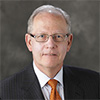Download PDF

By David W. Parke II, MD, Executive Vice President/CEO
On Dec. 31, an Academy member, “Dr. Smith,” e-mailed, showing the frustration and anger that ophthalmologists can feel with the SGR debacle and Medicare payment decisions. While the Academy hasn’t won every battle, we should appreciate the work of the many ophthalmologist-volunteers who contribute thousands of hours of time on behalf of their colleagues. Here is my response to Dr. Smith—abridged to fit.
Dear Dr. Smith: As physicians who finished training in 1983, you and I have felt the same changes in reimbursement. I empathize when you note that it’s tough to consider Academy lobbying as “diligent and effective” when cataract reimbursement is “40 percent less than in 1983.”
First, I’ll state the obvious: 16,000 U.S. ophthalmologists cannot singlehandedly turn the massive beast that is Congress and the administration. But by building coalitions and focusing on ophthalmology-related issues we can have—and have had—an impact! And that impact can be huge though sometimes invisible. Let me give you an example: In the mid-2000s, the Academy believed that ophthalmologists’ costs of practice were undervalued in setting Medicare rates. Naturally, this got no attention at the AMA or Medicare. We therefore spent about $100,000 to assemble the data and then built the coalition to drive Medicare acceptance of new ophthalmology practice expense values in 2009. This resulted in increased reimbursement. The value to ophthalmologists is over $400 million annually! Put another way, the average ophthalmologist receives over $20,000 every year from that effort—and they wouldn’t have gotten it without the Academy.
More recently, as part of “paying for” the short-term SGR fix just announced Jan. 1, there have been big cuts in reimbursement in imaging (CTs, ultrasound, etc.). Our in-office B-scans, visual fields, and IOL calculations were also on the list. The Academy managed to get those removed.
Without question, this year was bad for cataract surgery reimbursement. However, the impact of Academy and ASCRS volunteers and lobbyists prevented it from being worse. And the initial proposals were worse.
Although reimbursement changes have not been pretty for typical ophthalmology practices, we have done better than many of our peers. Looking at the past five years (2009 to 2013 Medicare fee schedules), the total five-year percent impact is +3 percent for ophthalmology; –3 percent for neurosurgery, –10 percent for urology, –7 percent for vascular surgery, etc.
During the past decade, Medicare payments to a reasonably constant number of ophthalmologists increased from $3.9 billion to $5.1 billion. In part, that increase came from the practice expense recalculation. In addition, the Academy demonstrated that malpractice premiums warranted higher reimbursement.
Dr. Smith, I don’t disagree that ophthalmologists have taken big (and many unwarranted) reimbursement cuts. But I disagree that this results from a failure on the part of the Academy, its staff, and its many ophthalmologist-volunteers who serve on committees in advocacy, health policy, and federal affairs. While we all are deeply frustrated by recent reimbursement decisions, without the Academy’s work things would have been far worse.
___________________________
For more on payment, see this month's D.C. Report.